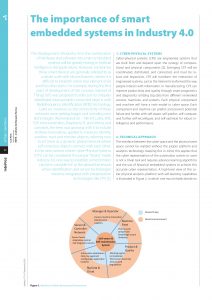The development of Industry 4.0 is the combination of hardware and software into smart embedded systems will be greatly resting in Artificial Intelligence (AI) applications. However, sometimes those smart devices are generally referred to as a whole scale with blurred barriers, where it is difficult to establish when one element ends and the other starts. For example, during the first years of development of this concept, Internet of Things (IoT) was proposed to refer just to uniquely identifiable interoperable connected objects with Radiofrequency Identification (RFID) technology. Later on, however, as the connectivity of these networks were getting bigger and including new technologies (Narrowband IoT – NB-IoT, LoRa, Wifi, ESP microcontrollers, Raspberry Pi, and others) and concepts, the term was growing with it to include all these innovations, applied to measure, identify, position, track and monitor objects, referring now to IoT more as a dynamic global network where self-conscious objects connect with each other. In this new context where Cyber-Physical Systems (CPS) can be considered the proper “brains” inside industry 4.0, one way to establish some frontiers can be to consider IoT as the global framework where identification and sensor technologies become integrated with interpretation technologies like CPS [1].
Cyber-physical systems
Cyber-physical systems (CPS) are engineered systems that are built from and depend upon the synergy of computational and physical components [2]. Emerging CPS will be coordinated, distributed, and connected, and must be robust and responsive. CPS will transform the interaction of engineered systems, just as the Internet transformed the way people interact with information. In manufacturing, CPS can improve productivity and quality through smart prognostics and diagnostics utilizing big data from different networked sensors, machines, and systems. Each physical component and machine will have a twin model in cyber space. Each component and machine can predict and prevent potential failure and further with self-aware, self-predict, self-compare, and further self-reconfigure, and self optimize for robust intelligence and performance.
Luís Pires
INETE – Instituto de Educação Técnica
Para ler o artigo completo faça a subscrição da revista e obtenha gratuitamente o link de download da revista “robótica” nº117. Pode também solicitar apenas este artigo através do email: [email protected]
Outros artigos relacionados
- Artigo de Opinião “A importância da automação na Indústria 4.0“;
- Dossier “O Sistema MES na Indústria 4.0” da edição 119 da revista “robótica”;
- Dossier “indústria 4.0” da edição 104 da revista “robótica”;
- Dossier “I5.0 – Revolução Industrial e Visão Artificial” da edição 117 da revista “robótica”;
- Artigo “Industry 4.0: an overview from the perspective of a German-headquartered firm – 1.st Part” da edição 105 da revista “robótica”;
VOCÊ PODE GOSTAR
Strategies to Reduce Power Consumption in pico-Satellites
Unusual Robotic Arm [Braço robótico incomum]
Extending I/O Interfaces for Phoenix Contact PLC using ESP-NOW wireless microcontrollers
Neptune.Controller: smart system for water assisted injection moulding based on fluid flow and heat transfer
Robot colaborativo em tarefas de polimento




